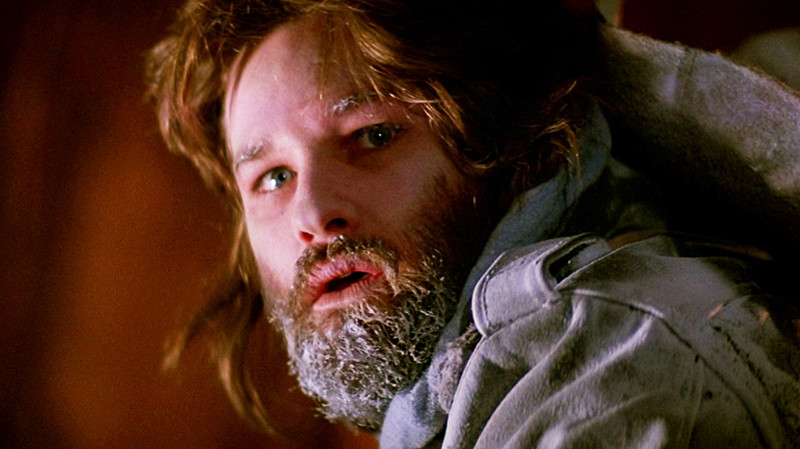
Growing up with my brother in the 1980s we spent a great deal of time watching wonderfully inappropriate horror films, mostly on pay TV or late night cable.
Peeking through fingers, knowing we shouldn’t be seeing what we were seeing but unable and often unwilling to turn away as our hearts jackhammered our spines, thrilled at the scary spectacle unraveling before us; sneering monsters with crimson claws and drooling fangs, certain to inspire nightmares and night lights.
These late nights would lead to a lifelong fascination with genre films, and so, with a whiff of nostalgia in the air and a devilish grin, recounted here are some of the best fright films the 1980s have to offer, and, despite some lazy tropes, overkill of slasher franchises, and uneasy exploitation misfires, the horror film had a heyday of artistic and commercial successes.
30. Demons (1985)
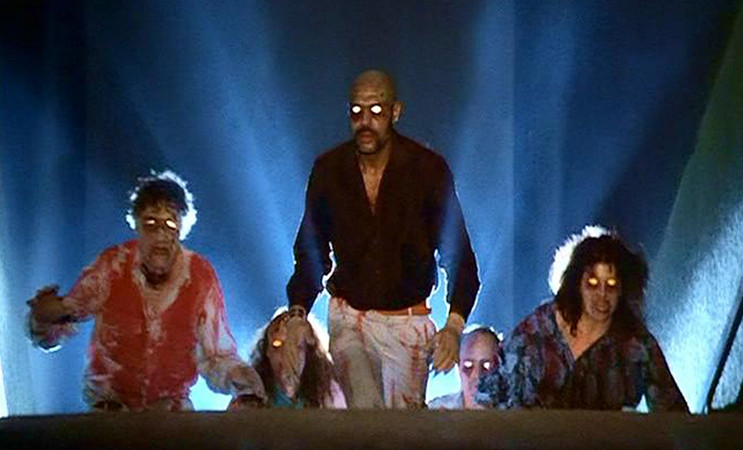
All the greats of Italian horror seem to splatter and converge in this energetic romp. Produced by Dario Argento, directed by Lamberto Bava—Mario Bava’s son—with an eerie score by Goblin’s Claudio Simonetti, and gruesome gore effects by Sergio Stivaletti, Demons is a devilish delight of fine and perverse pedigree.
In many ways the ultimate midnight movie/party favorite, Demons chronicles the outbreak of a demon apocalypse that originates in Berlin, at a creepy old movie theater called the Metropol where the events being shown on the screen begin to echo on the ill-fated theater patrons.
Featuring motorcycling sword-wielding decapitations, deus ex machina helicopter crashes, impressive demonic transformations, and shockingly brutal death scenes,
Demons is catnip for die-hard horror fans, and the then trendy 1980s soundtrack and fashions ups the ecstasy considerably. Also, this was the first in a franchise that would see six sickening sequels, none as nasty and enthralling as this one.
29. Child’s Play (1988)
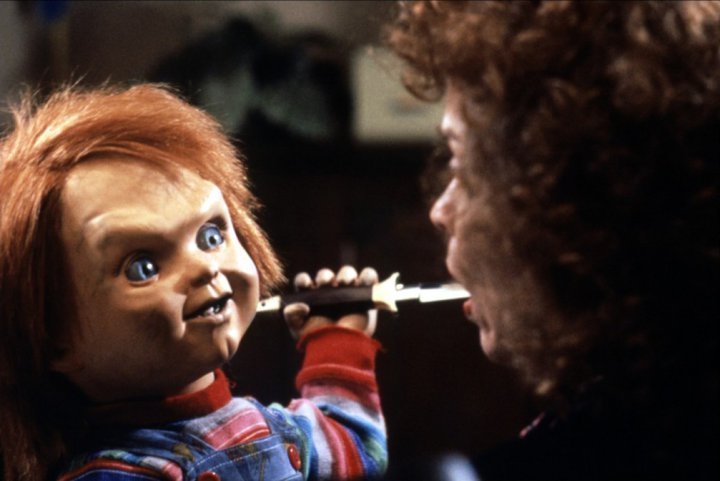
Serial killer Charles Lee Ray, as portrayed by an especially slimy Brad Dourif, uses voodoo to transfer his soul into the plastic body of a “Good Guy” doll, thus setting the stage for Tom Holland’s killer-doll-running-amok franchise starter, Child’s Play.
While not the first or finest killer doll movie––Stuart Gordon’s Dolls is pretty daring and delightful, too––Child’s Play is a fine example of an effects heavy horror film with lots of ingenuity, 80s arcana, and considerable intelligence for this sort of film.
Much more than a killer Cabbage Patch doll, Chucky would prove to be a durable villain, as quip-spouting as Freddy Krueger, as merciless as Jason Vorhees, and similarly as iconic, anything that’s dated, or of the period in Child’s Play simply bolsters its persistence.
The subsequent Chucky films relied on camp quality and humor, the original, while offering some comic relief, is serious about amassing scares and giving the audience a supernatural horror film with danger, disquiet, and enjoyable elation.
28. The Blob (1988)
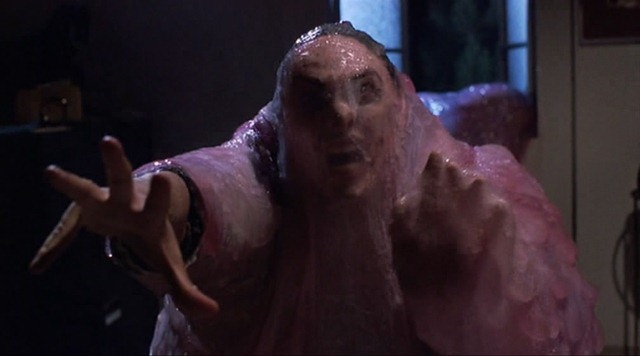
Chuck Russell won the hearts of many a 1980s horror buff after directing A Nightmare on Elm Street 3: The Dream Warriors and then following it up with this remake of the 1958 drive-in classic,The Blob.
While it mostly tanked at the box office, it reigned on home video, due in part to the dashing motorcycle-riding badass Brian Flagg (Kevin Dillon), his daring and resourceful love interest Meg Penny (Shawnee Smith), and the goopy purple-y creature effects of Tony Gardener.
The Blob is a great creature feature that plays with the tropes of the teen exploitation flick and even anticipates the meta-horror and self-aware chic that would become a popular genre staple in the 90s courtesy of the Scream films.
As far as fun fright flicks go, as well as being very emblematic of the 80s adoration for practical special effects, The Blob is a surprisingly slick and fist-pumping picture worthy of a reassessment.
27. From Beyond (1986)
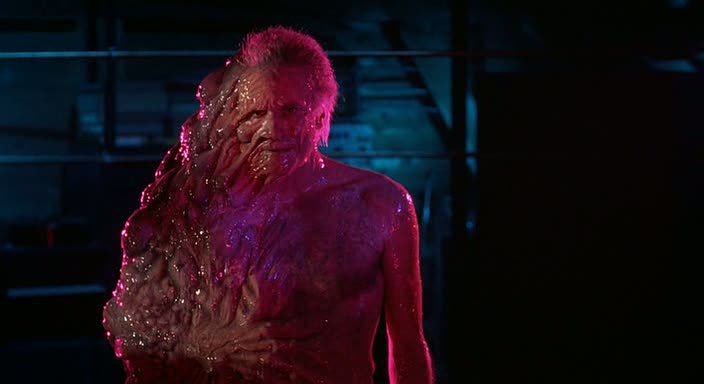
The 1980s were a good decade for B-movie maven Stuart Gordon, particularly with his Lovecraft adaptations. Arriving hot on the heels of his 1985 reworking of Re-Animator, From Beyond reunited Gordon with the same leads, Jeffrey Combs and Barbara Crampton in another depraved, decidedly trashy, and rather stylish fright fest that oozes with slime and goop.
Combs is Dr. Tillinghast, the hero of the tale whose merciless mad scientist boss, Dr, Pretorious (Ted Sorel) has invented a dimension-opening device he calls the Resonator which affects the pineal gland, and well, conjures up toothy worms, violent fish, and other slimy things.
The plot is very inconsequential as the kinky sex, grotesque creatures, and giftedly gory kills and disfigurements drive most of the plot. The satire, slime, and deviance on display marks Gordon as the bastard lovechild of, say, James Whale and John Waters. If that idea intrigues you, From Beyond will transport you to a clammy and caustic Promised Land.
26. The Fog (1980)
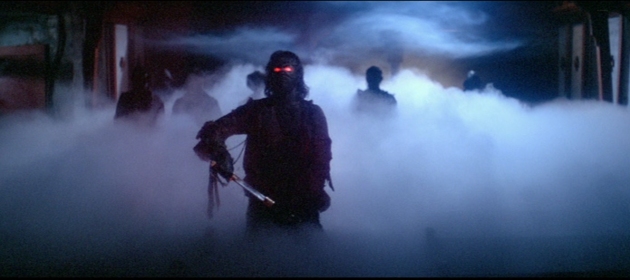
A stylish and unassuming genre gem, John Carpenter’s The Fog is a slow burning, character driven, and distinctly startling old-fashioned ghost story. With a driving, ominous score by the man himself, Carpenter along with writing partner/producer Debra Hill, take pains to effectively fashion the tragic tale surrounding Antonio Bay, a coastal town in California with a dark history that, on the eve of the town’s centennial, is about to come screaming as it catches up with it.
With a strong cast including Carpenter’s then-wife Adrienne Barbeau, and scream queens Jamie Lee Curtis, and Janet Leigh, The Fog takes it’s time unfolding as the many protagonists come to learn the history of Antonio Bay, which involves the deliberate destruction of the Elizabeth Dane, a 19th century clipper, occupied with a leper colony.
As a strange fog envelopes the town and sightings of a ghost ship and her haunted crew start to surface, the coming horrors and other-worldliness comes off something like a skewered American folktale.
Sure, there are some gaping plot holes and the narrative makes some logical leaps you’re best to just roll with, the end result in The Fog is a fright favorite, despite or perhaps because of all the horror clichés––so many jump scares!––that still generate sizable goosebumps and easy-to-appreciate plaudits.
25. Poltergeist (1982)
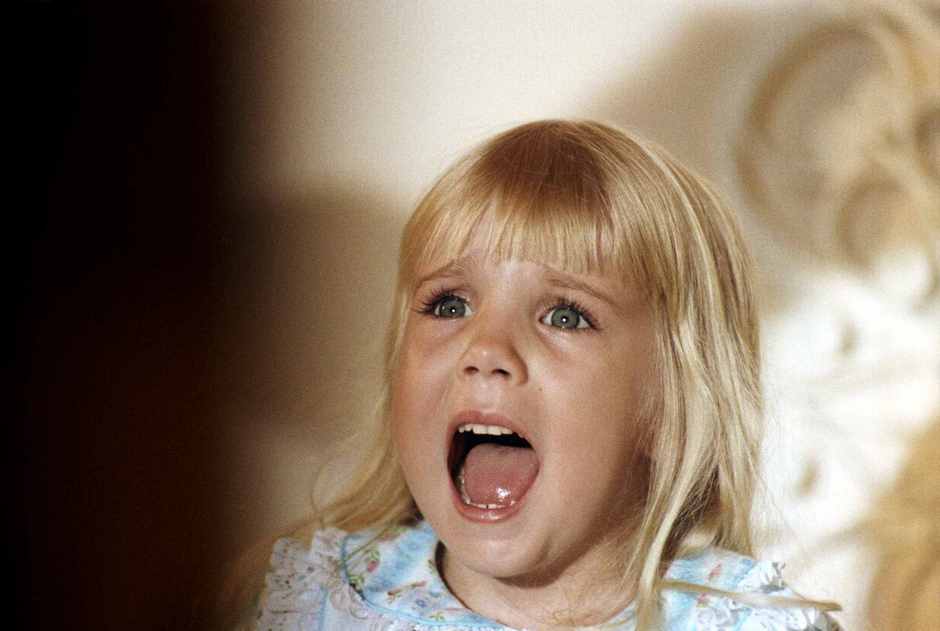
While eschewing the vérité vibe that made his debut, The Texas Chainsaw Massacre (1974), so memorably intense, director Tobe Hooper’s haunted house hit Poltergeist, still manages to be an effective and eerie film, and one that influenced scores imitators ever since.
Much lip service has been paid to suggest that producer Steven Spielberg exerted a lot of dominance over Hooper during the production, and the film’s effects-heavy, awe-inducing flourishes, and prudent pacing do speak largely to Spielberg’s strengths and signature style, so there may be a lot of truth to this, but regardless, the resulting supernatural horror is a chilling popcorn film of the highest derivation.
Married couple Steve and Diane, expertly portrayed by Craig T. Nelson and JoBeth Williams, move their family to Cuesta Verde, California, a planned community that the developers neglected to mention was built over top of a cemetery. Heather O’Rourke’s starturn as young daughter Carol “They’re here!” Anne and her TV set exodus is one of the film’s most remembered moments, but for me, well, let’s just say I never wanted a clown doll in my bedroom ever, ever again. ‘Nuff said.
24. Prince of Darkness (1987)
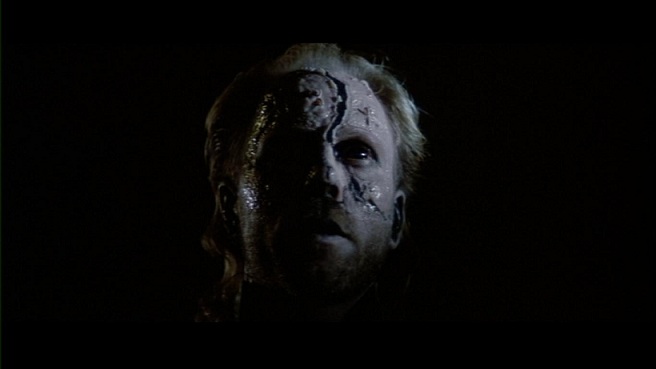
John Carpenter’s films in the 1980’s may have been critical and commercial failures at the time (with a few notable exceptions like Escape from New York), but they’ve aged well, not just as artifacts of 80’s genre cinema, but also as gratifying midnight movies, worthy of the cult status they’ve pretty much all attained.
Titles like Big Trouble in Little China (1986), and They Live (1988) are affectionately remembered, but his apocalyptic, atmospheric, and spine-tingling horror from 1987, Prince of Darkness, is also worthy of revisitation. With a game cast of some of Carpenter’s best and most menacing regulars, like Donald Pleasance, and Victor Wong, not to mention a show-stopping bit part from Alice Cooper.
Prince of Darkness showcases all the elements that make Carpenter great; an overly dramatic yet absolutely awesome synth-saturated soundtrack by Carpenter (which, like his best work is an homage to Dario Argento’s “house band” if you will, Goblin), scenes of shocking violence, tense stand-offs, at times ludicrous plot twists, dark humor, memorable dialogue, a heaping helping of cornball theatrics, just enough pseudo-science to lend some credibility, and an ending to make you jump out of your seat. Prince of Darkness is a scream.
23. Henry: Portrait of a Serial Killer (1986)
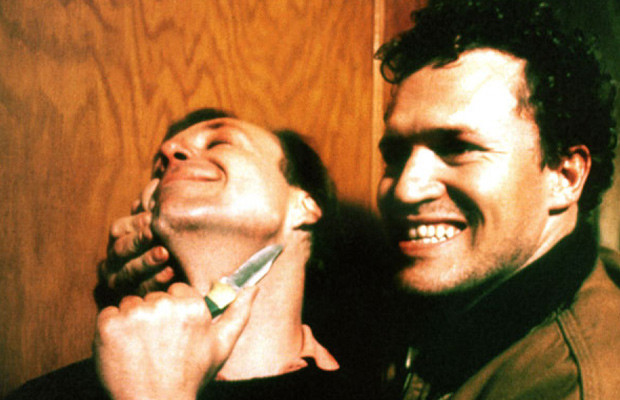
Don’t be dissuaded by the decidedly downbeat Midwestern setting, John McNaughton’s unflinching and unforgettable study of human evil, Henry: Portrait of a Serial Killer is a terrifying touchstone of infamous Americana.
Based loosely on the real life monster Henry Lee Lucas, portrayed memorably by veteran character actor Michael Rooker, McNaughton’s movie melds pseudo-documentary motifs and hand-held vérité embellishments like stylistically realistic sequences with grit and a gloomy visual palette.
Nothing about Henry: Portrait of a Serial Killer feels forced or flashy, and it is by no means easy to sit through. It feels authentic and inhumane and predicted future films like Silence of the Lambs and Se7en in it’s portrayal of evil, inhumanity, and cynicism.
22. Hellraiser (1987)
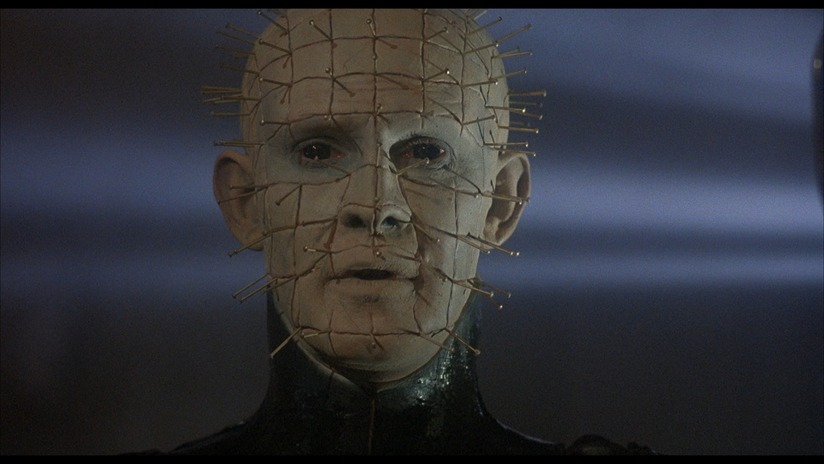
Clive Barker’s transgressive, subversive, and shocking directorial debut, based off his own novella, Hellraiser is a celebration of primal trauma, Freudian imagery, and deviant horror cinema writ large.
Landing like an incendiary device amongst the Thatcher era’s atavistic morality malaise and acerbic family values terrain, Barker brought terror, psychosexual symbolism, S&M, and a new horror icon dubbed Pin Head (Doug Bradley), gnashing and showboating into the subculture for audiences to admire.
And while Hellraiser has some narrative provocations and dated designs – a stop-motion monster, for instance, doesn’t pack the punch it once did – Barker’s Cenobites, and surreal imagery jump started a series of spin-offs and sequels that are still subjugating fans far and wide.
21. My Bloody Valentine (1981)
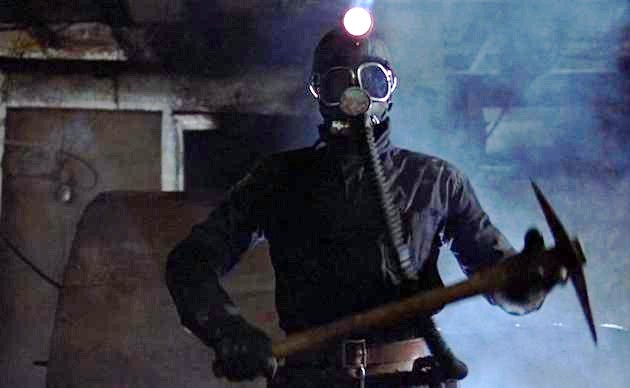
George Mihalka’s on-the-cheap slasher film My Bloody Valentine somehow manages to contain every trope and chestnut the genre has to offer and still entertain and alarm the audience as it goes.
A group of teenage coeds with raging hormones and a knack for trouble can barely contain themselves with enthusiasm for the upcoming Valentine’s Day Dance in the small town of Valentine Bluff. But what Sarah (Lori Hailer) and her oversexed teenybopper buddies are wont to forget is that twenty years hence Valentine Bluff was the scene of a terrible tragic incident at the nearby mine that resulted in several deaths and a touch of cannibalism, too. Or so the legend goes.
My Bloody Valentine doesn’t exactly break new ground, it mostly retreads it, but it does so with considerable élan and venom, emblematic of the era, it’s also widely considered a guilty pleasure, and one that Quentin Tarantino regularly cites as his favorite.
The influential Scottish shoegaze band My Bloody Valentine also, obviously, count themselves as fans, as do American rockers Good Charlotte (they have a song named after and inspired by the film) and Patrick Lussier (Dracula 2000) made a 3D remake in 2009.
An exceptionally violent slasher film with self-reflexive glimmerings, gallow’s humor, a memorable villain, and the requisite combination of creative kills and rejoinders, My Bloody Valentine is something of a standard.